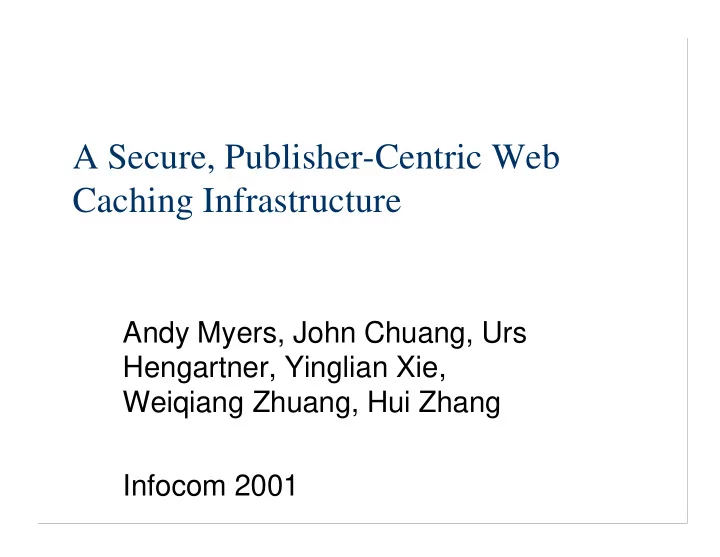

A Secure, Publisher-Centric Web Caching Infrastructure Andy Myers, John Chuang, Urs Hengartner, Yinglian Xie, Weiqiang Zhuang, Hui Zhang Infocom 2001
Caching Cache Server Clients � 30-40% reduction in bandwidth at ISP � Reduced waiting time for users � Lower load on publisher’s server Infocom 2001 2 April 26, 2001
But… � Caches don’t meet publishers’ demands � Logging of user accesses � Publishers routinely “cache bust” to get log information � Generation of dynamic content � Lots of content uncacheable because it has a dynamic component � Result: reduction in performance Infocom 2001 3 April 26, 2001
Make cache publisher-centric � Do a bit for the publisher, get back a big performance increase � Need to increase flexibility � Solution: Java! � Publisher writes cache applets to generate content � Can perform custom logging Infocom 2001 4 April 26, 2001
Gemini 1. Request 2. Request’ Active Cache 3. Java code, data 4. Reply (HTML, gif, …) 5. Logs � Active cache generates reply for client based on code sent by publisher � Later, cache returns access logs Infocom 2001 5 April 26, 2001
Example applications � MyYahoo � Cache assembles preset components � Cache could act as front-end for publisher database � AmIHotOrNot.com � Caches send ratings feedback in logs � Content adaptation � 56K vs. DSL vs. WAP � Cache thins content for constrained client Infocom 2001 6 April 26, 2001
Challenges � Building an active cache � Addressed by previous work � Incremental deployment � Some help from HTTP � Security � Unaddressed until now Infocom 2001 7 April 26, 2001
Outline � The security problem � Current solutions inadequate � New approach to security � Implementation � Related work & conclusion Infocom 2001 8 April 26, 2001
New security problems 1. Request 2. Request’ 3. Code/data 4. Reply 5. Logs � Cache lies to client � Cache lies to publisher � (Malicious code sent to cache) Infocom 2001 9 April 26, 2001
Strawman: Public key signatures Request Request’ Evil Cache Bogus Reply Reply’ � Cache supposed to alter content, so publisher signature meaningless to client � Cache can still lie Infocom 2001 10 April 26, 2001
Strawman: Secure coprocessor Cache Processor Secure Cache Coprocessor Code HTML � Secure coprocessor is trusted by everyone � Runs all publisher code � Expensive and inflexible Infocom 2001 11 April 26, 2001
Outline � The security problem � Current solutions inadequate � New approach to security � Implementation � Related work & conclusion Infocom 2001 12 April 26, 2001
Observations � Securing individual request/reply pairs is expensive/difficult � Publisher always knows what the right answer is � Can we put publisher back into the loop? Infocom 2001 13 April 26, 2001
Solution architecture � Authorization � Publisher chooses caches to trust � Authentication � Cache authenticates itself to client � Client can tell that a cache is authorized to serve a URL � Provides non-repudiation � Verification � Client and publisher both verify that authorized caches are behaving Infocom 2001 14 April 26, 2001
Auth. basics � Build on a Public Key Infrastructure (PKI) � PKI provides a way to bind public keys to names � E.g. “CNN.com’s key is AD23428F989…” � Binding is in the form of a certificate � We assume a Certificate Authority � Everyone trusts it � Everyone knows its public key, K_CA Infocom 2001 15 April 26, 2001
Meaning of a certificate � Identity CNN K_CNN K_CA � E.g. CNN’s public key is K_CNN � Authorization URL U K_Cache K_CNN � E.g. CNN (the entity which knows K_CNN) authorizes the cache with key K_Cache to serve URL U Infocom 2001 16 April 26, 2001
Basic authorization Private Key Request U Request U’ K_Cache Reply K_Cache Reply’ K_CNN CNN K_CNN K_CA CNN K_CNN K_CA URL U K_Cache K_CNN URL U K_Cache K_CNN � CNN authorizes cache to serve U � Cache signs its reply to client Infocom 2001 17 April 26, 2001
Authorization with delegation Request U Request U’ Reply K_Cache Reply’ K_CNN CNN K_CNN K_CA CNN K_CNN K_CA URL U K_UL K_CNN URL U K_UL K_CNN Honest K_Cache K_UL Honest K_Cache K_UL Underwriters’ Laboratories Infocom 2001 18 April 26, 2001
Recursive delegation Request U Request U’ Reply K_Cache Reply’ K_CNN CNN K_CNN K_CA CNN K_CNN K_CA URL U K_UL K_CNN URL U K_UL K_CNN Honest K_AOL K_UL Cache K_Cache K_AOL Honest K_AOL K_UL Underwriters’ Laboratories Infocom 2001 19 April 26, 2001
Verification � Trusted cache can misbehave � Could be compromised � Administrator could be bribed � Clients, publisher need to check cache’s output Infocom 2001 20 April 26, 2001
Verification design 1. Request 2. Reply 3. Logs 4. Verify: Request, Reply � Client sends verification request with some probability, p Infocom 2001 21 April 26, 2001
Verification limitations � Possible � Checking cache’s reply to client � Verifying that cache has not deleted logs � Future work � Verifying that cache has not added bogus log entries Infocom 2001 22 April 26, 2001
System architecture Infocom 2001 23 April 26, 2001
Performance Gemini - miss Regular - miss Gemini - hit Regular - hit Infocom 2001 24 April 26, 2001
Related work � Active proxies (Active Cache, HPP) � WWW security (SSL, HTTPS, DSig, HTTP Digest Authentication) � Mobile agents (e.g. Yee’s Sanctuary) � Secure hardware (e.g. IBM’s coprocessor) Infocom 2001 25 April 26, 2001
Conclusion � Caches need to become more publisher-centric � We have addressed the security issues of publisher-centric caching � Authorization, Authentication, Verification � We have implemented our ideas by adding a Java VM to Squid � Performance enhancement is future work Infocom 2001 26 April 26, 2001
Recommend
More recommend